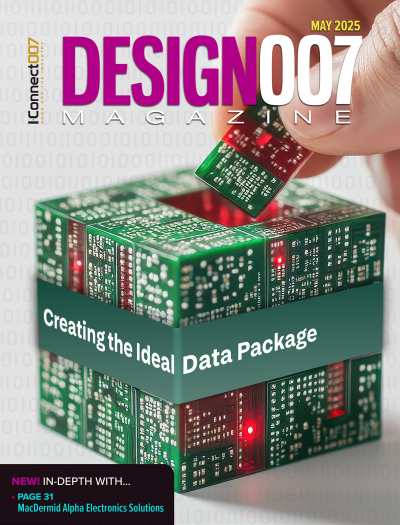-

- News
- Books
Featured Books
- design007 Magazine
Latest Issues
Current Issue
Showing Some Constraint
A strong design constraint strategy carefully balances a wide range of electrical and manufacturing trade-offs. This month, we explore the key requirements, common challenges, and best practices behind building an effective constraint strategy.

All About That Route
Most designers favor manual routing, but today's interactive autorouters may be changing designers' minds by allowing users more direct control. In this issue, our expert contributors discuss a variety of manual and autorouting strategies.

Creating the Ideal Data Package
Why is it so difficult to create the ideal data package? Many of these simple errors can be alleviated by paying attention to detail—and knowing what issues to look out for. So, this month, our experts weigh in on the best practices for creating the ideal design data package for your design.
- Articles
- Columns
- Links
- Media kit
||| MENU - design007 Magazine
Slash Sheets: Don’t Fall Into the Trap
June 8, 2023 | Geoffrey Hazelett, Technical SalesEstimated reading time: 2 minutes
Slash sheets can be confusing, and this is a big topic, so let’s start big and drill down from there.
Here’s the big picture regarding slash sheet references: They were designed to provide handy groupings of PCB materials (laminates, polyimides, etc.) that go into a stackup. These groupings are designed around mechanical characteristics to provide insight for PCB fabricators to identify similar laminates with similar properties.
These documents were not designed to be used by PCB designers to help select the correct material for their job. For high-speed designers in particular, these group references can be a trap. While two material families may have similar mechanical processing characteristics for fabricators, the materials can have wildly dissimilar electrical characteristics. Dielectric constant (Dk), dissipation factor (Df), copper roughness values, and glass weave styles (106/1080/3313, etc.) are all significant for signal integrity and are not appropriately distinguished within slash sheets.
For example, due to this ambiguity of electrically significant values, two electrically dissimilar performing materials could be substituted for one another. The two materials may have similar processing temperatures and roughly similar characteristics; to savvy PCB designers with an eye for signal integrity, slash sheets fall short.
For example, IPC-4101/126 has a maximum Dk value of 5.4, and a Df of 0.035. To use Isola materials as an example, this lumps 185HR, 370HR, IS550H, IS415, FR408HR, and I-Speed all together. So, if a designer needed high-frequency performance with something like I-Speed, but allowed a substitution with /126, their fabricator would likely swap the material to something else. That other material could likely be a 185HR or 370HR, which have significantly differing Dk/Df values as well as differing glass weave types.
A designer who wants to control the materials in their stackup is often pressed to communicate specific acceptable alternative supplier laminates, such as “Panasonic Megtron 6 (or Isola I-Speed),” to their fabricator.
To use shoes as an analogy: Shoes generally all have a sole, laces, breathable top, etc. A slash sheet reference would help identify “shoes,” but doesn’t help identify “running shoes” vs. "hiking boots." Nike and Adidas both make running shoes, so a designer could use “/shoes” (slash sheet reference), but they may be in trouble if they are running a marathon and want “Nike or Adidas running shoes.” A limitation of the slash sheets is that there are significant differences between the brands and the types of shoes, and unfortunately they could all be lumped together in the same slash sheet for “shoes.”
A designer should clearly communicate with the fabricator regarding the desired glass weave, resin type, etc., going into their board if they wish to ensure their signal integrity characteristics will be met. Don’t take unnecessary short cuts when a few more words can save a world of headache.
Geoffrey Hazelett has a bachelor of science degree in electrical engineering, and was vice president of sales at Polar Instruments for several years. He is currently home with his new baby daughter, Sage.
This article originally appeared in the May 2023 issue of Design007 Magazine.
Testimonial
"Our marketing partnership with I-Connect007 is already delivering. Just a day after our press release went live, we received a direct inquiry about our updated products!"
Rachael Temple - AlltematedSuggested Items
Statement from the Global Electronics Association on the July 2025 Tariff on Copper Foil and Electronics-Grade Copper Inputs
07/31/2025 | Global Electronics AssociationWe are disappointed by today’s decision to impose a 50% tariff on imported copper foil and other essential materials critical to electronics manufacturing in the United States.
Considering the Future of Impending Copper Tariffs
07/30/2025 | I-Connect007 Editorial TeamThe Global Electronics Association is alerting industry members that a potential 50% tariff on copper could hit U.S. electronics manufacturers where it hurts.
Connect the Dots: Sequential Lamination in HDI PCB Manufacturing
07/31/2025 | Matt Stevenson -- Column: Connect the DotsAs HDI technology becomes mainstream in high-speed and miniaturized electronics, understanding the PCB manufacturing process can help PCB design engineers create successful, cost-effective designs using advanced technologies. Designs that incorporate blind and buried vias, boards with space constraints, sensitive signal integrity requirements, or internal heat dissipation concerns are often candidates for HDI technology and usually require sequential lamination to satisfy the requirements.
OKI Launches Rigid-Flex PCBs with Embedded Copper Coins Featuring Improved Heat Dissipation for Space Equipment Applications
07/29/2025 | BUSINESS WIREOKI Circuit Technology, the OKI Group’s printed circuit board (PCB) business company, has developed rigid-flex PCBs with embedded copper coins that offer improved heat dissipation for use in rockets and satellite-mounted equipment operating in vacuum environments.
Designers Notebook: Basic PCB Planning Criteria—Establishing Design Constraints
07/22/2025 | Vern Solberg -- Column: Designer's NotebookPrinted circuit board development flows more smoothly when all critical issues are predefined and understood from the start. As a basic planning strategy, the designer must first consider the product performance criteria, then determine the specific industry standards or specifications that the product must meet. Planning also includes a review of all significant issues that may affect the product’s manufacture, performance, reliability, overall quality, and safety.


